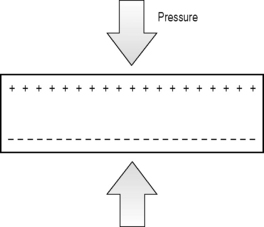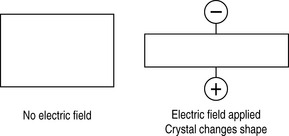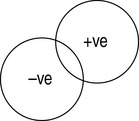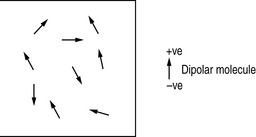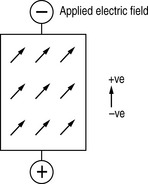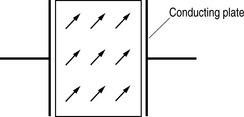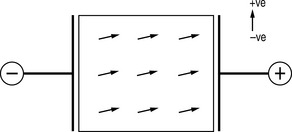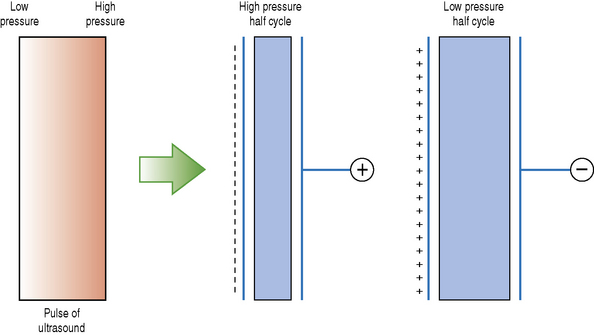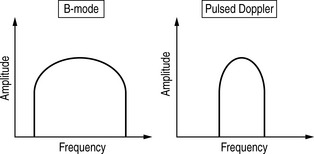Chapter 3 The piezoelectric effect
THE PIEZOELECTRIC EFFECT
This is the ability of a material to generate an electrical charge in response to applied pressure. When a piece of piezoelectric material is compressed a potential difference is generated across opposite faces – the one side becomes positive, the other negative (Fig. 3.1). Conversely, if an electric field is applied across the crystal it changes its shape (Fig. 3.2).
PIEZOELECTRIC MATERIALS
This property is exhibited by certain crystalline materials such as quartz, which is a naturally occurring crystal, and lead zirconate titanate, which is a man-made ceramic.
Piezoelectric materials are crystalline materials composed of dipolar molecules, which are positive at one end and negative at the other (Fig. 3.3). Normally these dipolar molecules have a random arrangement within the material and they are unable to align themselves with an applied electric field (Fig. 3.4). However, if the material is heated above the Curie temperature in the presence of an electric field, the molecules will align themselves with that field. If the material is then allowed to cool below the Curie temperature, while the electric field is maintained, the molecules will remain aligned to the electric field and maintain this position even after the field is removed (see Fig. 3.5). This piezoelectric crystal can now be used in an ultrasound transducer to transmit and to detect sound. Opposite faces of the crystal have conducting plates attached to their surfaces. These surfaces are at right angles to the previously applied electric field (Fig. 3.6).
THE PIEZOELECTRIC CRYSTAL AS A TRANSMITTER OF SOUND
In this case the crystal is converting electrical energy into mechanical energy. A voltage is applied to the conducting plates causing the molecules to twist in the direction of the electric field and this causes the crystal to become thicker (Fig. 3.7). If this voltage is reversed the molecules will twist back in the opposite direction making the crystal thinner (Fig. 3.8). Applying an alternating voltage to the crystal will cause it to expand and contract (oscillate) at the same frequency as the voltage, producing a continuous sound wave of that frequency. The degree of expansion and contraction is known as the amplitude of oscillation and is dependent partly on the voltage. Increasing the applied voltage increases the amplitude of oscillation. The amplitude of oscillation is also dependent on the resonant frequency of the crystal (see below).
THE PIEZOELECTRIC CRYSTAL AS A RECEIVER OF SOUND
In this case the crystal is converting mechanical energy into electrical energy. When a sound wave makes contact with a piezoelectric crystal the regions of high pressure and low pressure cause the crystal to contract and expand. This twists the dipolar molecules which results in the conducting plates becoming charged either positive and negative or negative and positive (Fig. 3.9). In other words, small voltage signals are produced from the sound wave. The size of the voltage signal produced depends upon the amplitude (loudness or strength) of the sound wave. Sound with higher amplitude results in a signal with a higher voltage.
PRODUCTION OF A PULSED SOUND WAVE
The process described above is for the production and detection of a continuous sound wave, the frequency of the sound wave being equal to the frequency of the applied voltage. However, when producing a pulsed sound wave the crystal is subjected to a very short pulse of high voltage electricity, typically 500 V and 1 microsecond, which produces a pulse of sound approximately 2 wavelengths long. The frequency of the sound produced depends upon the thickness of the crystal. In fact, the natural frequency of the crystal is such that the wavelength of the pulse of sound emitted equals twice the thickness of the crystal.
RESONANCE
This is is the tendency of an object to oscillate at maximum amplitude at a certain frequency. For example, if a series of voltages of different frequencies are applied to a piezoelectric crystal, the surfaces of the crystal will oscillate at the frequency of the applied voltage. However, at a certain frequency the amplitude of the oscillation will be much greater than at any other frequency. This is known as the resonant frequency or natural frequency of the crystal.
FACTORS AFFECTING WAVELENGTH/FREQUENCY
The frequency output from a piezoelectric crystal depends upon the thickness of the crystal and the type of voltage applied to the crystal. For B-mode ultrasound a short pulse of high voltage electricity is applied. This is typically 500 volts and 2 wavelengths long. In this case the crystal emits a range of frequencies, with the center frequency equal to the resonant frequency. With continuous Doppler ultrasound a continuous alternating voltage is applied to the crystal, which emits a sound wave of a single frequency equal to the frequency of the applied voltage. For pulsed Doppler ultrasound a longer pulse of ultrasound is applied, typically 8–10 wavelengths long. This emits a short pulse of sound with a center frequency equal to that of the applied voltage. Although there are a range of frequencies present in this pulse, the range is narrower than that produced in B-mode imaging (Fig. 3.10).
IMPORTANT PROPERTIES OF PIEZOELECTRIC MATERIALS
Acoustic Impedance
The acoustic impedance of the piezoelectric crystal should be chosen so that it is as close to the acoustic impedance of the patient’s skin as practicable. This is to ensure that there is efficient transfer of sound energy between the crystal and the patient. If there is a large acoustic impedance mismatch between crystal and the patient’s skin then a large amount of energy is reflected at the interface and only a small amount transmitted. This affects both the transmission and reception of sound.
Energy Conversion Efficiency
This is the efficiency of the piezoelectric crystal to convert electrical energy into sound energy and to convert sound energy into electrical energy. Both types of conversion efficiency (electricity into sound and sound into electricity) are important in ensuring efficient production of ultrasound and sensitivity in detecting weak echoes.
